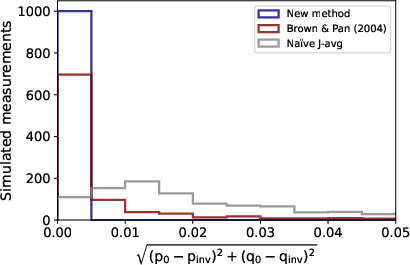- The paper introduces a novel bias-free method that leverages a von Mises distribution and explicit likelihood function to reliably measure the Kuiper belt's mean plane.
- Monte Carlo simulations show that the new approach recovers the true mean plane within <1° in 100% of trials, outperforming traditional methods.
- Detection of a ~15° local warp in the 80–200 AU range implies dynamical influence from an unseen planetary body in the outer solar system.
Measurement and Interpretation of the Mean Plane of the Distant Kuiper Belt
Introduction
This paper presents a rigorous analysis of the mean plane of the distant Kuiper belt, focusing on non-resonant trans-Neptunian objects (TNOs) with semimajor axes in the range $50-400$ AU. The authors introduce a novel, bias-free statistical method for mean plane determination, overcoming limitations of previous approaches that were susceptible to survey selection effects. The paper leverages a comprehensive sample of 154 non-resonant TNOs, classified using machine learning techniques, and applies both Monte Carlo simulations and n-body integrations to assess the presence and origin of any deviation from the solar system's invariable plane.
Methodology: Bias-Free Mean Plane Measurement
Traditional methods for mean plane estimation, such as orbit-normal averaging and the Brown & Pan (2004) symmetry maximization technique, are shown to be vulnerable to observational bias, particularly in the presence of non-uniform survey footprints. The new method introduced here models the intrinsic distribution of orbital planes using a von Mises distribution and constructs a likelihood function that is explicitly independent of the survey selection function and the energy/angular momentum distribution of the TNOs. This approach enables direct estimation of the mean plane and its uncertainty, conditioned only on the observed angular momentum directions.
Monte Carlo simulations with synthetic TNO populations and randomized survey footprints demonstrate the superiority of the new method: it consistently recovers the true mean plane within <1∘ for 100% of trials, compared to ∼80% for the Brown & Pan method and ∼20% for naive averaging.

Figure 1: Distribution of distances of simulated measurements of the mean plane from the actual mean plane for each of the three measurement methods in the Monte Carlo simulation.
Empirical Results: Detection of a Local Warp
Applying the bias-free method to the real TNO sample, the mean plane is found to be consistent with the invariable plane for $50-80$ AU and $200-400$ AU bins, corroborating previous studies. However, in the $80-200$ AU and $80-400$ AU bins, the mean plane exhibits a statistically significant deviation: 2.52σ and 2.74σ tension, corresponding to false alarm probabilities of 4% and 2%, respectively. The measured warp has an inclination of i0∼15∘ and longitude of node Ω0∼120∘, though uncertainties remain substantial due to sample size.

Figure 2: Mean plane measurement using the new bias-free method and probability contours for the invariable plane across semimajor axis bins.
Robustness tests using synthetic populations and survey footprints confirm that the observed warp is unlikely to be an artifact of small-number statistics or selection bias.
Dynamical Interpretation: Constraints on an Unseen Planet
The persistence of a local warp in the mean plane at large semimajor axes cannot be explained by primordial disk misalignment, as differential nodal precession would erase such features on timescales ≲108 yr. n-body simulations incorporating the Sun, giant planets, and an additional hypothetical planet reveal that a planet with mass between Mercury and Earth (∼0.06−1M⊕), semimajor axis $100-200$ AU, and inclination ≳10∘ can induce and maintain a warp of the observed amplitude and location. Lower-mass bodies (down to Pluto-mass) are not excluded, but their efficacy is reduced.
Simulations show that higher-mass planets (>1M⊕) tend to warp the mean plane at smaller semimajor axes ($50-80$ AU), which is not observed, while planets with ap≳200 AU fail to produce the required warp in the $80-200$ AU bin. The direction of the warp in simulations is not always strictly aligned or anti-aligned with the planet's node, indicating deviations from linear secular theory predictions.

Figure 3: Simulated mean plane measurement and probability ellipses for the same TNOs after n-body integration with an additional planet at ap=160 AU, ip=20∘.
Implications and Future Prospects
The detection of a local warp in the mean plane of the distant Kuiper belt, if confirmed, provides dynamical evidence for the possible existence of an unseen planetary-mass body in the outer solar system, distinct from the hypothesized "Planet Nine" invoked to explain apsidal clustering. The mass and orbital constraints derived here are consistent with limits from planetary ephemerides and stability analyses. The upcoming LSST survey is expected to either confirm the presence of the warp with a larger TNO sample or directly detect the responsible planet if it resides within the survey footprint.
The methodology developed in this work sets a new standard for bias-free dynamical measurements in the outer solar system and can be generalized to other small body populations. The results also motivate further theoretical and numerical studies of secular and resonant dynamical processes in the presence of additional planetary perturbers.
Conclusion
This paper introduces a robust, bias-free statistical framework for measuring the mean plane of the Kuiper belt and applies it to the largest and most rigorously classified sample of non-resonant TNOs to date. The detection of a statistically significant local warp at $80-400$ AU, and its dynamical interpretation as the possible signature of an unseen planet, represents a substantive advance in our understanding of the architecture and dynamical evolution of the outer solar system. Future surveys and improved dynamical modeling will be essential to confirm these findings and further constrain the properties of any additional planetary bodies beyond Neptune.


